


 |
 |
 |
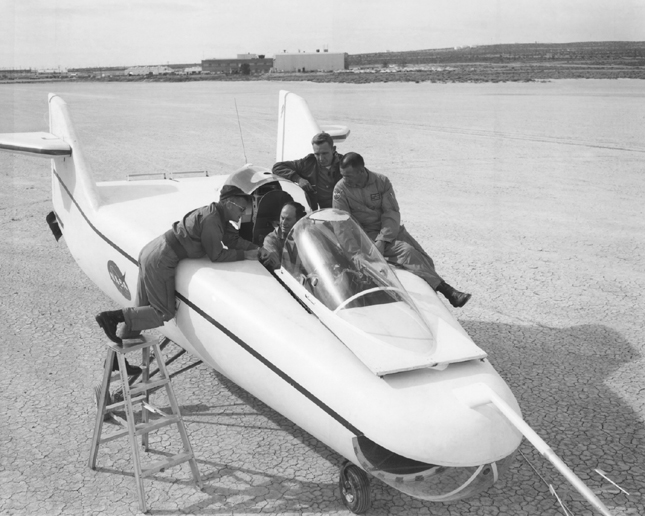
Chuck Yeager, Milt Thompson, Don Malick, and Bruce Peterson with the M2-Fl Lifting Body
The NASA High Range Tracking stations were located at Ely and Beatty Nevada with main control being at Dryden/Edwards AFB in California. The tracking station crew at Beatty, Nevada consisted of a Station Manager, a Technical Advisor, and field engineers for the Mod-2 Radar, Data Transmission System, Communications, Telemetry, and Plant Maintenance/Generators. NASA had a site monitor at each tracking station to monitor contractor operations.
Though supporting flights of the X-15 was the main objective, they also participated in flights of the XB-70, an occasional A-12/SR-71 Blackbird flight, various experimental Lunar Landing vehicles, and the Lifting Bodies depicted below.
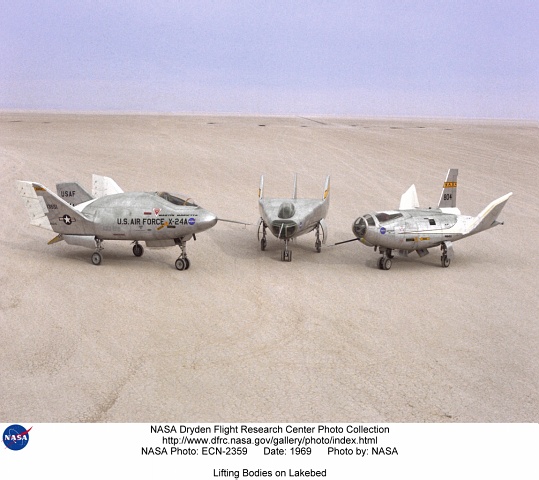
A fleet of lifting bodies flown at NASA's Flight Research Center (FRC) at Edwards Air Force Base from 1963 to l975 demonstrated the ability of pilots to maneuver and safely land a wingless vehicle. These lifting bodies were designed to validate the concept of flying a wingless vehicle back to Earth from space and landing it like an aircraft at a pre-determined site.
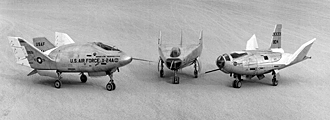
These unique research vehicles, with their unconventional aerodynamic shapes, were the M2-F1, M2-F2, M2-F3, HL-10, X-24A, and the X-24B. The information the lifting body program generated contributed to the database that led to development of the space shuttle program.
Aerodynamic lift - essential to flight in the atmosphere - was obtained from the shape of the vehicles rather than from wings as on a normal aircraft. The addition of fins and control surfaces allowed the pilots to stabilize and control the vehicles and regulate their flight paths.
All but the M2-F1 were powered by the same type of XLR-11 rocket engine used in the Bell X-1 - the first aircraft to fly faster than the speed of sound. The M2-F1, a lightweight prototype, was unpowered.
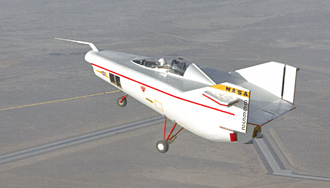
The original idea of lifting bodies was conceived about 1957 by Dr. Alfred J. Eggers Jr., then the assistant director for Research and Development Analysis and Planning at the Ames Aeronautical Laboratory, now the NASA Ames Research Center at Moffett Field, Calif.
NASA's predecessor, the National Advisory Committee for Aeronautics, had earlier been investigating the problems associated with re-entry of missile nose cones. H. Julian Allen, another Ames engineer, determined that a blunt nose cone was a desirable shape to survive the aerodynamic heating associated with re-entry from space. Eggers found that by slightly modifying a symmetrical nose cone shape, aerodynamic lift could be produced. This lift would enable the modified shape to fly back from space rather than plunge to earth in a ballistic trajectory.
The lifting body concept was originally tested at Dryden with a plywood prototype designated the M2-F1 and built in late 1962. It featured a plywood shell built by Gus Briegleb, a sailplane builder from Mirage Dry Lake, Calif., placed over a tubular frame built at Dryden. The M2-F1 was towed aloft, first behind an auto and then a C-47 more than 100 times, to validate basic lifting body stability and control characteristics. This led to establishment of the formal program which resulted in the HL-10 and its sister vehicles. These studies by Eggers, Allen, and their associates led to the design known as the M-2, a modified half-cone, rounded on the bottom and flat on top, with a blunt, rounded nose and twin tail-fins. This configuration and those of the later lifting bodies allowed them to be maneuvered both in a lateral and a longitudinal direction so they could be landed on a runway rather than simply parachuting into the ocean as did the contemporary ballistic capsules used in the Mercury, Gemini, and Apollo programs.
Northrop Corporation built the HL-10. The contract for construction of the HL-10 and the M2-F2, first of the fleet of lifting bodies flown at Dryden and also built by Northrop, was $1.8 million. "HL" stands for horizontal landing, and "10" refers to the tenth design studied by engineers at NASA's Langley Research Center, Hampton, Va.
The HL-10 was delivered to NASA in January 1966. During the next 10 months it was instrumented for the research program and prepared for flight. The HL-10 and the M2-F2 were tested in wind tunnels at Ames before research flights began.
First flight of the HL-10 was on Dec. 22, 1966, with research pilot Bruce Peterson in the cockpit. Although an XLR-11 rocket engine was installed in the vehicle, the first 11 drop flights from the B-52 launch aircraft were powerless glide flights to assess handling qualities, stability and control.
The HL-10 was flown 37 times during the lifting body research program and logged the highest altitude and fastest speed in the program. On Feb. 18, 1970, Air Force test pilot Peter Hoag piloted the HL-10 to Mach 1.86 (1,228 mph). Nine days later, NASA pilot Bill Dana flew the vehicle to 90,030 feet, which became the highest altitude reached in the program.
During a typical lifting body flight, the B-52 -- with the research vehicle attached to the pylon mount on the right wing between the fuselage and inboard engine pod -- flew to a height of about 45,000 feet and a launch speed of about 450 mph.
Moments after being dropped, the XLR-11 rocket engine (same type engine used in the Bell X-l) was ignited by the pilot. Speed and altitude increased until the engine was shut down by choice or fuel exhaustion, depending upon the individual mission profile. The lifting bodies normally carried enough fuel for about 100 seconds of powered flight and routinely reached altitudes of 50,000 to 80,000 feet and speeds above Mach 1.
Following engine shutdown, the pilot maneuvered the vehicle through a simulated return-from-space corridor into a pre-planned approach for a landing on one of the lakebed runways on Rogers Dry Lake at Edwards. A circular approach was used to lose altitude during the landing phase. On the final approach leg, the pilot increased his rate of descent to build up energy. At about 100 feet altitude, a "flare out" maneuver dropped air speed to about 200 mph for the landing.
The HL-10 helped develop energy management and landing techniques used presently with the space shuttle orbiters.
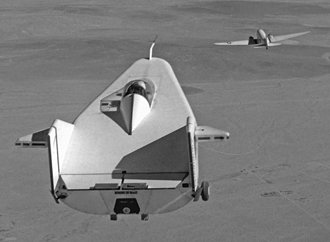
(The photo depicts the M2-F1 being towed in flight by a C-47}
In 1962, FRC Director Paul Bikle approved a program to build a lightweight, unpowered lifting body as a prototype to flight test the wingless concept. It would look like a "flying bathtub," and was designated the M2-F1. Built by sailplane designer Gus Briegleb, it featured a plywood shell placed over a tubular steel frame crafted at the FRC. Construction was completed in 1963.
The first flight tests saw the M2-F1 towed aloft by a hopped-up Pontiac convertible driven at speeds up to 120 mph across Rogers Dry Lake. These initial tests produced enough flight data about the M2-F1 to proceed with flights behind a NASA R4D tow plane at greater altitudes. The R4D (the Navy designation of the C-47 or civil DC-3) towed the craft to an altitude of 12,000 ft. where it was released to fly freely back to Rogers Dry Lake. NASA research pilot Milt Thompson flew the M2-F1 during the first series of tests.
Typical glide flights with the M2-F1 lasted several minutes at speeds of 110 to l20 mph.
More than 400 ground tows and 77 aircraft tow flights were carried out with the M2-F1 before it was retired. A historical artifact now owned by the Smithsonian's National Air and Space Museum, the M2-F1 is on long-term loan to NASA Dryden and has been restored to flight-like condition.
The success of Dryden's M2-F1 program led to NASA's development and construction of two heavyweight lifting bodies based on studies at NASA's Ames and Langley research centers - the M2-F2 and the HL-10, both built by Northrop Corporation. The "M" refers to "manned" and "F" refers to "flight." "HL" comes from "horizontal landing" and "10" is for the 10th lifting body design that was investigated by Langley.
The Air Force later became interested in lifting body research and had a third design concept, the X-24A, built by the Martin Company. It was later modified into the X-24B and both configurations were flown in the joint NASA - Air Force lifting body program at Dryden.
The basic flight profile of the heavyweight lifting bodies involved being air-launched by NASA's modified NB-52B "mothership" at an altitude of about 45,000 feet. The XLR-11 rocket engine was then ignited and the vehicle accelerated to speeds of up to 1,100 mph and to altitudes of 60,000 to 70,000 feet. After the rocket engine was shut down, the pilots began steep glides towards the Edwards runway. As the pilots entered the final approach leg, they increased their rate of descent to build up speed and used this energy to perform a "flare out" maneuver and slow their landing speed to about 200 mph - the same basic approach pattern and landing speed of today's space shuttles.
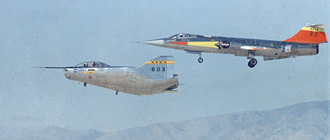
The first flight of the M2-F2 - which looked much like the M2-F1 - occurred on July 12, 1966 with Thompson again at the controls. By then, the same B-52 used to air launch the famed X-15 rocket research aircraft had been modified to also carry the lifting bodies into the air. The M2-F2 was dropped from the B-52's wing pylon mount at an altitude of 45,000 feet on that maiden glide flight.
The M2-F2 weighed 4,620 pounds without ballast, was roughly 22 feet long, and had a width of about 10 feet.
On May 10, 1967, during the 16th glide flight, a landing accident severely damaged the vehicle and seriously injured the NASA pilot, Bruce Peterson. (Film footage of the crash was later used in the opening sequence of the popular 1970s-era television show, "The Six-million Dollar Man.")
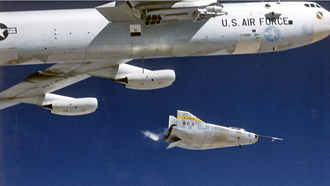
NASA pilots said the M2-F2 had lateral control problems that led to the crash, even though it had a stability augmentation control system. When the M2-F2 was rebuilt and redesignated the M2-F3, it was modified with an additional third vertical fin - centered between the tip fins - to improve control characteristics.
The first flight of the M2-F3, with NASA pilot Bill Dana at the controls, occurred on June 2, 1970. It was a glide flight to evaluate changes in the vehicle's performance due to the modifications. The modified vehicle exhibited much better lateral stability and control characteristics than had the M2-F2.
Over the next 26 missions, the M2-F3 reached a top speed of l,064 mph (Mach 1.6). Dana was the pilot on that high-speed mission, which took place on Dec. 13, 1972. The highest altitude reached by the M2-F3 was 71,500 feet on Dec. 20, 1972, the date of its last flight, with NASA pilot John Manke at the controls.
A reaction jet control system, similar to thrusters used on orbiting spacecraft, was also installed on the M2-F3 to obtain research data about their effectiveness for vehicle control. As the M2-F3's portion of the lifting body program neared an end, it evaluated a rate command augmentation control system and a side-arm control stick similar to side-arm controllers now used on many modern aircraft.
The M2-F3 is now on display in the National Air and Space Museum, Washington, D. C.
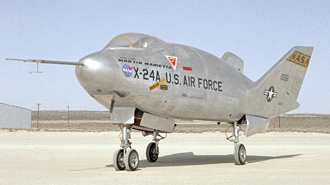
Built for the Air Force by Martin, the X-24A was a bulbous-shaped aircraft, with three vertical fins at the rear for directional control. It weighed 6,270 pounds without propellants, was just over 24 feet long, and had a width of nearly 14 feet.
The first unpowered glide flight of the X-24A occurred on April 17, 1969, flown by Air Force Maj. Jerauld Gentry. Gentry also piloted the vehicle on its first powered flight on March 19, 1970.
The X-24A was flown 28 times in a program which, like that of the HL-10, helped validate the concept that a wingless vehicle could be landed unpowered. Some three decades later, X-38 program managers elected to use the X-24A design to save money, since the existing X-24A aerodynamic database was complete. This limited the number of wind tunnel tests that would have been required for a totally new design.
Fastest speed recorded by the the X-24A was 1,036 mph (Mach 1.6), and the maximum altitude reached by the craft was 71,400 feet. Both of those flights were flown by NASA research pilot John Manke, who was also the pilot on its final flight on June 4, 1971.
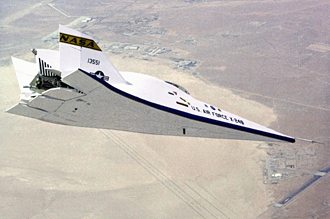
The X-24B's design evolved from a family of potential re-entry shapes proposed by the Air Force Flight Dynamics Laboratory, each with higher lift-to-drag ratios.
To reduce the costs of constructing a research vehicle, the Air Force returned the X-24A to Martin for modifications that converted its bulbous shape into one resembling a "flying flatiron" - a rounded top, flat bottom, and a double-delta planform that ended in a pointed nose.
Manke was first to fly the X-24B, a glide flight on Aug. 1, 1973. He was also the pilot on the first powered mission on Nov. 15, 1973.
Among the final flights with the X-24B were two precise landings on the main concrete runway at Edwards, which showed that accurate unpowered re-entry vehicle landings were operationally feasible. These missions, flown by Manke and Air Force Maj. Mike Love, represented the final milestone in a program that helped write the flight plan for today's space shuttle landings.
The final powered flight with the X-24B was on Sept. 23, l975, flown by Bill Dana. It was also the last rocket-powered lifting body flight flown at Dryden. Ironically, it was Dana who also flew the last X-15 rocket plane mission about seven years earlier.
Top speed reached by the X-24B was 1,164 mph (Mach 1.75) by Love on Oct. 25, 1974. The highest altitude reached was 74,100 feet by Manke on May 22, 1975.
The X-24B is now on public display at the Air Force Museum, Wright-Patterson AFB,Ohio.
The M2-F1 lifting body, dubbed the "flying bathtub" by the media, was the precursor of a remarkable series of wingless flying vehicles that contributed data used in the Space Shuttles, the X-33 Advanced Technology Demonstrator for the next century's Reusable Launch Vehicle, and the X-38 Technology Demonstrator for crew return from the International Space Station.
Based on the ideas and basic design of Alfred J. Eggers and others at the Ames Aeronautical Laboratory (now the Ames Research Center), Mountain View, California, in the mid-1950's, the M2-F1 was built in 1962-63 over a four-month period for a cost of only about $30,000, plus an additional $8,000-$10,000 for an ejection seat. Engineers and technicians at the NASA Flight Research Center (now NASA Dryden) kept costs low by designing and fabricating it partly in-house, with the plywood shell constructed by a local sailplane builder. Someone at the time estimated that it would have cost a major aircraft company $150,000 to build the same vehicle.
Unlike the later lifting bodies, the M2-F1 was unpowered and was initially towed by a souped-up Pontiac convertible until it was airborne. Later a C-47 took over the towing duties. Flown by such famous research pilots as Milt Thompson, Bruce Peterson, Chuck Yeager, and Bill Dana, the lightweight flying bathtub demonstrated that a wingless vehicle shaped for reentry into the Earth's atmosphere from space could be flown and landed safely.
Flown from 1963 to 1966, the lightweight M2-F1 paved the way for the heavyweight M2-F2, M2-F3, HL-10, X-24A, and X-24B lifting bodies that flew under rocket power after launch from a B-52 mothership. The heavyweights flew from 1966 to 1975, demonstrating the viability and versatility of the wingless configuration and the ability of a vehicle with low lift-over-drag characteristics to fly to high altitudes and then to land precisely with their rocket engines no longer burning. Their unpowered approaches and landings showed that the Space Shuttles need not decrease their payloads by carrying fuel and engines that would have been required for conventional, powered landings. The lifting bodies also prepared the way for the later X-33 and X-38 programs that feature lifting-body shapes.
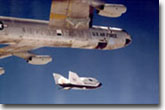
The HL-10 was one of five aircraft built in the Lifting Body Research Program. It was a NASA design and was built to evaluate "inverted airfoil" lifting body and delta planform. It was flown 37 times during the lifting body research program and logged the highest altitude and fastest speed in the Lifting Body program.
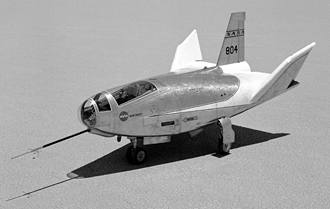
The other designs were the M2-F2, M2-F3 (rebuilt M2-F2 following a landing accident), X-24A and X-24B (rebuilt X-24A with a different aerodynamic shape).
Wingless lifting bodies attained aerodynamic stability and lift from the shape of the vehicle. Lift resulted from more air pressure on the bottom of the body than on the top. They used energy and aerodynamic lift for in-flight maneuvering and a powerless, glider-like landing.
The HL-10 was delivered to the FRC by Northrop in January 1966, and first flew some 11 months later on Dec. 22 of the same year.
The HL-10 was one of five aircraft built in the Lifting Body Research Program. It was a NASA design and was built to evaluate "inverted airfoil" lifting body and delta planform. The HL-10 was one of five heavyweight lifting-body designs flown at NASA's Flight Research Center (FRC--later Dryden Flight Research Center), Edwards, California, from July 1966 to November 1975 to study and validate the concept of safely maneuvering and landing a low lift-over-drag vehicle designed for reentry from space. Northrop Corporation built the HL-10 and M2-F2, the first two of the fleet of "heavy" lifting bodies flown by the NASA Flight Research Center. The contract for construction of the HL-10 and the M2-F2 was $1.8 million. "HL" stands for horizontal landing, and "10" refers to the tenth design studied by engineers at NASA's Langley Research Center, Hampton, Va.
After delivery to NASA in January 1966, the HL-10 made its first flight on Dec. 22, 1966, with research pilot Bruce Peterson in the cockpit. Although an XLR-11 rocket engine was installed in the vehicle, the first 11 drop flights from the B-52 launch aircraft were powerless glide flights to assess handling qualities, stability, and control. In the end, the HL-10 was judged to be the best handling of the three original heavy-weight lifting bodies (M2-F2/F3, HL-10, X-24A).
The HL-10 (tail #804) was flown 37 times during the Lifting Body Research Program and logged the highest altitude and fastest speed in the program. First flight was Dec. 22 1966. On Feb. 18, 1970, Air Force test pilot Peter Hoag piloted the HL-10 to Mach 1.86 (1,228 mph). Nine days later, NASA pilot Bill Dana flew the vehicle to 90,030 feet, which became the highest altitude reached in the program.
Some new and different lessons were learned through the successful flight testing of the HL-10. These lessons, when combined with information from it's sister ship, the M2-F2/F3, provided an excellent starting point for designers of future entry vehicles, including the Space Shuttle.
First flight of the HL-10 was on Dec. 22, 1966. The first 11 drop flights from the B-52 launch aircraft were powerless glide flights to assess handling qualities, stability, and control.
During its 37 flights the HL-10 set several program records. On Feb. 18, 1970, Air Force test pilot Maj. Peter Hoag flew it to 1,228 mph (Mach 1.86), the fastest speed reached by any of the lifting bodies. Nine days later, NASA's Bill Dana flew the HL-10 to 90,303 feet, the highest altitude reached by any of the lifting body craft. The HL-10 was also the first lifting body to fly supersonically - on May 9, 1969, with Manke at the controls.
The HL-10 featured a longitudinally curved bottom and a laterally rounded top and had a delta planform. In its final configuration, three vertical fins, two of them canted outward from the body and a tall center fin, gave the craft directional control. A flush canopy blended into the smooth rounded nose. It was about 21 feet long, with a span of 13.6 feet. Its glide-flight weight was 6,473 lbs. and its maximum gross weight was over 10,000 lbs.
Flights of the HL-10 contributed substantially to the decision to design the space shuttles without air-breathing engines that would have been used for powered landings. The HL-10 flew its final flight on July 17, 1970, and the craft is now is now on public display at the entrance to NASA Dryden.
 NASA research pilot Bill Dana takes a moment to watch NASA's NB-52B cruise overhead after a research flight in the HL-10. On the left, John Reeves can be seen at the cockpit of the lifting body.
NASA research pilot Bill Dana takes a moment to watch NASA's NB-52B cruise overhead after a research flight in the HL-10. On the left, John Reeves can be seen at the cockpit of the lifting body.
 The HL-10, seen here parked on the ramp, was one of five lifting body designs flown at NASA's Dryden Flight Research Center, Edwards, California, from July 1966 to November 1975 to study and validate the concept of safely maneuvering and landing a low lift-over-drag vehicle designed for reentry from space.
The HL-10, seen here parked on the ramp, was one of five lifting body designs flown at NASA's Dryden Flight Research Center, Edwards, California, from July 1966 to November 1975 to study and validate the concept of safely maneuvering and landing a low lift-over-drag vehicle designed for reentry from space.
 The HL-10 Lifting Body completes its first research flight with a landing on Rogers Dry Lake at Edwards AFB, California, on December 22, 1966. The HL-10 suffered from buffeting and poor control during the flight. Pilot Bruce Peterson was able to make a successful landing despite the severe problems. These were traced to airflow separation from the fins. As a result, the fins were no longer able to stabilize the vehicle. A small reshaping of the fins' leading edges cured the airflow separation, but it was not until March 15, 1968, that the second HL-10 flight occurred.
The HL-10 Lifting Body completes its first research flight with a landing on Rogers Dry Lake at Edwards AFB, California, on December 22, 1966. The HL-10 suffered from buffeting and poor control during the flight. Pilot Bruce Peterson was able to make a successful landing despite the severe problems. These were traced to airflow separation from the fins. As a result, the fins were no longer able to stabilize the vehicle. A small reshaping of the fins' leading edges cured the airflow separation, but it was not until March 15, 1968, that the second HL-10 flight occurred.
 The HL-10 Lifting Body completes its first research flight with a landing on Rogers Dry Lake. Due to control problems, pilot Bruce Peterson had to land at a higher speed than originally planned in order to keep the vehicle under control. The actual touchdown speed was about 280 knots. This was 30 knots above the speed called for in the flight plan. The HL-10's first flight had lasted 3 minutes and 9 seconds.
The HL-10 Lifting Body completes its first research flight with a landing on Rogers Dry Lake. Due to control problems, pilot Bruce Peterson had to land at a higher speed than originally planned in order to keep the vehicle under control. The actual touchdown speed was about 280 knots. This was 30 knots above the speed called for in the flight plan. The HL-10's first flight had lasted 3 minutes and 9 seconds.
 The HL-10 lifting body is seen here in flight over Rogers Dry Lake at Edwards AFB. After the vehicle's fins were modified following its first flight, the HL-10 proved to be the best handling of the heavy-weight lifting bodies flown at Edwards Air Force Base. The HL-10 flew much better than the M2-F2, and pilots were eager to fly it.
The HL-10 lifting body is seen here in flight over Rogers Dry Lake at Edwards AFB. After the vehicle's fins were modified following its first flight, the HL-10 proved to be the best handling of the heavy-weight lifting bodies flown at Edwards Air Force Base. The HL-10 flew much better than the M2-F2, and pilots were eager to fly it.
 The HL-10 Lifting Body is seen here in flight over Rogers Dry lakebed. Like the other lifting bodies, the HL-10 made a steep descent toward the lakebed, followed by a high-speed landing. This was due to the vehicle's low lift-over-drag ratio. The first 11 flights of the HL-10 were unpowered, flown to check the vehicle's handling and stability before rocket-powered flights began using the XLR-11 rocket engine.
The HL-10 Lifting Body is seen here in flight over Rogers Dry lakebed. Like the other lifting bodies, the HL-10 made a steep descent toward the lakebed, followed by a high-speed landing. This was due to the vehicle's low lift-over-drag ratio. The first 11 flights of the HL-10 were unpowered, flown to check the vehicle's handling and stability before rocket-powered flights began using the XLR-11 rocket engine.
 The HL-10 Lifting Body is seen here in powered flight shortly after launch from the B-52 mothership. When HL-10 powered flights began on October 23, 1968, the vehicle used the same basic XLR-11 rocket engine that powered the original X-1s. A total of five powered flights were made before the HL-10 first flew supersonically on May 9, 1969, with John Manke in the pilot's seat.
The HL-10 Lifting Body is seen here in powered flight shortly after launch from the B-52 mothership. When HL-10 powered flights began on October 23, 1968, the vehicle used the same basic XLR-11 rocket engine that powered the original X-1s. A total of five powered flights were made before the HL-10 first flew supersonically on May 9, 1969, with John Manke in the pilot's seat.
 The HL-10, seen here parked on the ramp at NASA's Flight Research Center in 1966, had a radically different shape from that of the M2-F2/F3. While the M2s were flat on top and had rounded undersides (giving them a bathtub shape), the HL-10 had a flat lower surface and a rounded top. Both shapes provided lift without wings, however. This photo was taken before the HL-10's fins were modified.
The HL-10, seen here parked on the ramp at NASA's Flight Research Center in 1966, had a radically different shape from that of the M2-F2/F3. While the M2s were flat on top and had rounded undersides (giving them a bathtub shape), the HL-10 had a flat lower surface and a rounded top. Both shapes provided lift without wings, however. This photo was taken before the HL-10's fins were modified.
 The HL-10 Lifting Body is seen here parked on Rogers Dry Lake, the unique location where it landed after research flights. This 1968 photo shows the vehicle after the fins were modified to remove instabilities encountered on the first flight. It involved a change to the shape of the leading edge of the fins to eliminate flow separation. It required extensive wind-tunnel testing at Langley Research Center, Hampton, Va. NASA Flight Research Center (FRC) engineer Bob Kempel than plotted thousands of data points by hand to come up with the modification, which involved a fiberglass glove backed with a metal structure on each fin's leading edge. This transformed the vehicle from a craft that was difficult to control into the best handling of the original group of lifting bodies at the FRC.
The HL-10 Lifting Body is seen here parked on Rogers Dry Lake, the unique location where it landed after research flights. This 1968 photo shows the vehicle after the fins were modified to remove instabilities encountered on the first flight. It involved a change to the shape of the leading edge of the fins to eliminate flow separation. It required extensive wind-tunnel testing at Langley Research Center, Hampton, Va. NASA Flight Research Center (FRC) engineer Bob Kempel than plotted thousands of data points by hand to come up with the modification, which involved a fiberglass glove backed with a metal structure on each fin's leading edge. This transformed the vehicle from a craft that was difficult to control into the best handling of the original group of lifting bodies at the FRC.
 Cockpit of the HL-10 lifting body |
 HL-10 Flight Simulator |
 This photo shows the HL-10 on lakebed with its subsonic control surface configuration. The unusual shapes of the lifting bodies, as well as the demands of flying a re-entry shape to comparative low-speed landings, required a complex set of control surfaces. The rudders also served as speed brakes, allowing the pilot to adjust his speed during descent. Moving the flaps at the rear of the fuselage in the same direction pitched the nose up, while moving them in opposite directions rolled the vehicle to the right or left. After the HL-10's fins were modified to improve its handling qualities, the vehicle proved to be the best handling of the original heavy-weight lifting bodies.
This photo shows the HL-10 on lakebed with its subsonic control surface configuration. The unusual shapes of the lifting bodies, as well as the demands of flying a re-entry shape to comparative low-speed landings, required a complex set of control surfaces. The rudders also served as speed brakes, allowing the pilot to adjust his speed during descent. Moving the flaps at the rear of the fuselage in the same direction pitched the nose up, while moving them in opposite directions rolled the vehicle to the right or left. After the HL-10's fins were modified to improve its handling qualities, the vehicle proved to be the best handling of the original heavy-weight lifting bodies.
 This photo shows the HL-10 in flight, turning to line up with lakebed runway 18. The pilot for this flight, the 29th of the HL-10 series, was Bill Dana. The HL-10 reached a peak altitude of 64,590 feet and a top speed of Mach 1.59 on this particular flight.
This photo shows the HL-10 in flight, turning to line up with lakebed runway 18. The pilot for this flight, the 29th of the HL-10 series, was Bill Dana. The HL-10 reached a peak altitude of 64,590 feet and a top speed of Mach 1.59 on this particular flight.
 In this photo, the HL-10 has touched down on its main landing gear, while the pilot was holding the nose up to slow the vehicle. The F-104 in the background was used as a chase plane. Its pilot would give the HL-10's pilot calls on his altitude above the lakebed as well as warnings about any problems. The NASA F-104s were also used for lifting-body training. With the landing gear extended and flaps lowered, the F-104 could simulate the steep, high-speed descent and landing of a lifting body.
In this photo, the HL-10 has touched down on its main landing gear, while the pilot was holding the nose up to slow the vehicle. The F-104 in the background was used as a chase plane. Its pilot would give the HL-10's pilot calls on his altitude above the lakebed as well as warnings about any problems. The NASA F-104s were also used for lifting-body training. With the landing gear extended and flaps lowered, the F-104 could simulate the steep, high-speed descent and landing of a lifting body.
 The HL-10 after its first flight, shown with pilot Bruce Peterson. Although the lifting-body aircraft was predicted to have good flying qualities, this first flight showed major control and stability problems. The cause was airflow separation from the vehicle's fins. Changes to the fins' leading-edge shape fixed the problem.
The HL-10 after its first flight, shown with pilot Bruce Peterson. Although the lifting-body aircraft was predicted to have good flying qualities, this first flight showed major control and stability problems. The cause was airflow separation from the vehicle's fins. Changes to the fins' leading-edge shape fixed the problem.
 The four principal HL-10 pilots are seen here with the lifting body aircraft. They are, left to right; Air Force Major Jerauld R. Gentry, Air Force test pilot Peter Hoag, and NASA pilots John A. Manke and Bill Dana. All are wearing the pressure suits needed for flying above 50,000 feet.
The four principal HL-10 pilots are seen here with the lifting body aircraft. They are, left to right; Air Force Major Jerauld R. Gentry, Air Force test pilot Peter Hoag, and NASA pilots John A. Manke and Bill Dana. All are wearing the pressure suits needed for flying above 50,000 feet.
 Not every moment of a test pilot's day is serious business. In a moment of levity, NASA pilots Bill Dana (left) and John A. Manke try to drag Air Force test pilot Peter Hoag away from the HL-10 lifting body while Air Force Major Jerauld R. Gentry helps from the cockpit. These four men were the principal pilots for the HL-10 program.
Not every moment of a test pilot's day is serious business. In a moment of levity, NASA pilots Bill Dana (left) and John A. Manke try to drag Air Force test pilot Peter Hoag away from the HL-10 lifting body while Air Force Major Jerauld R. Gentry helps from the cockpit. These four men were the principal pilots for the HL-10 program.
 This photo shows the HL-10 on Rogers Dry Lakebed with pilot Bill Dana in the foreground. Bill joined the HL-10 program in 1969 after flying the M2-F1 and the X-15, among other aircraft. His first glide flight was on April 25, 1969. Some months later, on September 3, 1969, he reached an altitude of 77,960 feet. This was one of a series of HL-10 flights to collect stability and control data at higher speeds and altitudes and at different angles of attack.
This photo shows the HL-10 on Rogers Dry Lakebed with pilot Bill Dana in the foreground. Bill joined the HL-10 program in 1969 after flying the M2-F1 and the X-15, among other aircraft. His first glide flight was on April 25, 1969. Some months later, on September 3, 1969, he reached an altitude of 77,960 feet. This was one of a series of HL-10 flights to collect stability and control data at higher speeds and altitudes and at different angles of attack.
 Dana later retired Chief Engineer at NASA's Dryden Flight Research Center, which was called only the NASA Flight Research Center in 1969. Prior to his lifting body assignment, Dana flew the famed X-15 research airplane. He flew the rocket-powered aircraft 16 times, reaching a top speed of 3,897 miles per hour and a peak altitude of 310,000 feet (almost 59 miles high).
Dana later retired Chief Engineer at NASA's Dryden Flight Research Center, which was called only the NASA Flight Research Center in 1969. Prior to his lifting body assignment, Dana flew the famed X-15 research airplane. He flew the rocket-powered aircraft 16 times, reaching a top speed of 3,897 miles per hour and a peak altitude of 310,000 feet (almost 59 miles high).
 Pilot Major Jerauld R. Gentry stands in front of the HL-10 Lifting Body. Gentry was the Air Force project pilot for the HL-10 while it was making the early glide and powered flights in 1968 following its modification. He made a total of nine flights in the vehicle. For his work on the HL-10, Gentry was awarded the Harmon International Trophy for his outstanding contribution to the science of flying. He later became the Air Force pilot for the X-24A.
Pilot Major Jerauld R. Gentry stands in front of the HL-10 Lifting Body. Gentry was the Air Force project pilot for the HL-10 while it was making the early glide and powered flights in 1968 following its modification. He made a total of nine flights in the vehicle. For his work on the HL-10, Gentry was awarded the Harmon International Trophy for his outstanding contribution to the science of flying. He later became the Air Force pilot for the X-24A.
 Air Force Major Peter Hoag stands in front of the HL-10 Lifting Body. Maj. Hoag joined the HL-10 program in 1969 and made his first glide flight on June 6, 1969. He made a total of 8 flights in the HL-10. They included the fastest lifting-body flight, which reached Mach 1.861 on Feb. 18, 1970.
Air Force Major Peter Hoag stands in front of the HL-10 Lifting Body. Maj. Hoag joined the HL-10 program in 1969 and made his first glide flight on June 6, 1969. He made a total of 8 flights in the HL-10. They included the fastest lifting-body flight, which reached Mach 1.861 on Feb. 18, 1970.
 The wingless, lifting body aircraft sitting on Rogers Dry Lake at what is now NASA's Dryden Flight Research Center, Edwards, California, from left to right are the X-24A, M2-F3 and the HL-10.The lifting body aircraft studied the feasibility of maneuvering and landing an aerodynamic craft designed for reentry from space. These lifting bodies were air launched by a B-52 mother ship, then flew powered by their own rocket engines before making an unpowered approach and landing. They helped validate the concept that a space shuttle could make accurate landings without power.
The wingless, lifting body aircraft sitting on Rogers Dry Lake at what is now NASA's Dryden Flight Research Center, Edwards, California, from left to right are the X-24A, M2-F3 and the HL-10.The lifting body aircraft studied the feasibility of maneuvering and landing an aerodynamic craft designed for reentry from space. These lifting bodies were air launched by a B-52 mother ship, then flew powered by their own rocket engines before making an unpowered approach and landing. They helped validate the concept that a space shuttle could make accurate landings without power.
 HL-10 Lifting Body and X-15 in front of a hangar at Dryden Flight Reaearch Center in 1966
HL-10 Lifting Body and X-15 in front of a hangar at Dryden Flight Reaearch Center in 1966
 Hangar 4802 at the NASA Flight Research Center in 1966. Aircraft on left include (left to right): HL-10, M2-F2, M2-F1, F-4A, F5D-1, F-104 (barely visible) and C-47. Aircraft on the right side (left to right) include: X-15-1 (56-6670), X-15-3 (56-6672), and X-15-2 (56-6671).
Hangar 4802 at the NASA Flight Research Center in 1966. Aircraft on left include (left to right): HL-10, M2-F2, M2-F1, F-4A, F5D-1, F-104 (barely visible) and C-47. Aircraft on the right side (left to right) include: X-15-1 (56-6670), X-15-3 (56-6672), and X-15-2 (56-6671).
In the table, the flight number stands for: free flight number-B-52 carry number.
| No. | Date | Flight No. | Pilot | Max. Altitude (ft-m) |
Max. Speed (mach-mph-kph) |
Flight Time (sec) | Remarks |
|---|---|---|---|---|---|---|---|
| 15 | 22 Dec. 1966 | 1-3 | Peterson | 45,000-13,720 | .69-457-735 | 187 | First flight. |
| 18 | 15 Mar. 1968 | 2-5 | Gentry | 45,000-13,720 | .61-425-684 | 243 | |
| 19 | 3 Apr. 1968 | 3-6 | Gentry | 45,000-13,720 | .69-455-732 | 242 | |
| 20 | 25 Apr. 1968 | 4-8 | Gentry | 45,000-13,720 | .69-459-739 | 258 | |
| 21 | 3 May 1968 | 5-9 | Gentry | 45,000-13,720 | .69-455-732 | 245 | |
| 22 | 16 May 1968 | 6-10 | Gentry | 45,000-13,720 | .68-447-719 | 265 | |
| 23 | 28 May 1968 | 7-11 | Manke | 45,000-13,720 | .66-434-698 | 245 | |
| 24 | 11 Jun. 1968 | 8-12 | Manke | 45,000-13,720 | .64-433-697 | 246 | |
| 25 | 21 Jun 1968 | 9-13 | Gentry | 45,000-13,720 | .64-423-681 | 271 | |
| 26 | 24 Sept. 1968 | 10-17 | Gentry | 45,000-13,720 | .68-449-722 | 245 | XLR-11 engine installed. |
| 27 | 3 Oct. 1968 | 11-18 | Manke | 45,000-13,720 | .71-471-758 | 243 | |
| 28 | 23 Oct. 1968 | 12-20 | Gentry | 39,700-12,100 | .67-449-722 | 189 | First powered flight. Premature shutdown |
| 29 | 13 Nov. 1968 | 13-21 | Manke | 42,650-13,000 | .84-524-843 | 385 | 2 chambers, 186-sec powered flight. |
| 30 | 9 Dec. 1968 | 14-24 | Gentry | 47,420-14,450 | .87-542-872 | 394 | 2 chambers. |
| 32 | 17 Apr. 1969 | 15-27 | Manke | 52,740-16,070 | .99-605-973 | 400 | 3 chambers. |
| 33 | 25 Apr. 1969 | 16-28 | Dana | 45,000-13,720 | .70-462-743 | 252 | Glide. |
| 35 | 9 May 1969 | 17-29 | Manke | 53,300-16,250 | 1.13-744-1197 | 410 | 3 chambers, first supersonic. |
| 36 | 20 May 1969 | 18-30 | Dana | 49,100-14,970 | .90-596-959 | 414 | |
| 37 | 28 May 1969 | 19-31 | Manke | 62,200-18,960 | 1.24-815-1311 | 398 | 2 chambers. |
| 38 | 6 June 1969 | 20-32 | Hoag | 45,000-13,720 | .67-452-727 | 231 | Glide. |
| 39 | 19 June 1969 | 21-33 | Manke | 64,100-19,540 | 1.40-922-1483 | 378 | 2 chambers. |
| 40 | 23 June 1969 | 22-34 | Dana | 63,800-19,450 | 1.27-839-1350 | 373 | 2 chambers. |
| 41 | 6 Aug. 1969 | 23-35 | Manke | 76,100-23,190 | 1.54-1020-1641 | 372 | First 4-chambered flight. |
| 43 | 3 Sept. 1969 | 24-37 | Dana | 77,960-23,760 | 1.45-958-1541 | 414 | 4 chambers. |
| 45 | 18 Sept. 1969 | 25-39 | Manke | 79,190-24,140 | 1.26-833-1340 | 426 | 4 chambers. |
| 47 | 30 Sept. 1969 | 26-40 | Hoag | 53,750-16,380 | .92-609-780 | 436 | 2 chambers. |
| 49 | 27 Oct. 1969 | 27-41 | Dana | 60,610-18,470 | 1.58-1041-1675 | 417 | |
| 50 | 3 Nov. 1969 | 28-42 | Hoag | 64,120-19,540 | 1.40-921-1482 | 439 | |
| 52 | 17 Nov. 1969 | 29-43 | Dana | 64,590-19,690 | 1.59-1052-1693 | 408 | |
| 53 | 21 Nov. 1969 | 30-44 | Hoag | 79,280-24,160 | 1.43-952-1532 | 378 | |
| 55 | 12 Dec. 1969 | 31-46 | Dana | 79,960-24,370 | 1.31-871-1401 | 428 | |
| 56 | 19 Jan. 1970 | 32-47 | Hoag | 86,660-26,410 | 1.31-869-1398 | 410 | |
| 57 | 26 Jan. 1970 | 33-48 | Dana | 87,684-26,730 | 1.35-897-1443 | 411 | |
| 58 | 18 Feb. 1970 | 34-49 | Hoag | 67,310-20,520 | 1.86-1228-1976 | 380 | Max. speed. |
| 60 | 27 Feb. 1970 | 35-51 | Dana | 90,303-27,524 | 1.31-870-1400 | 416 | Max. altitude. |
| 66 | 11 June 1970 | 36-52 | Hoag | 45,000-13,716 | .74-503-809 | 202 | Glide landing study. |
| 68 | 17 Jul. 1970 | 37-53 | Hoag | 45,000-13,716 | .73-499-803 | 252 |
Dimensions: Length, 22 ft. 2 in.; Width, 15 ft. 7 in.; Height, 11 ft. 5 in.; Min. Weight, 5,265 lbs.; Max. Weight, 9,000 lbs (with water ballast tanks full).
Controls: Elevons between vertical and center fins for pitch and roll control. Split rudder on center fin for yaw and speed control. All surfaces used in three-axis stabilizer-augmenter system.
Power: One XLR-11 four-chamber rocket engine fueled by ethyl alcohol and liquid oxygen, producing maximum of 6,000 lbs thrust; built by Chemical Reaction Motors Inc.
Auxiliary Power: Silver zinc batteries provided electrical power for control system, flight instruments, radios, cockpit heat, and stability augmentation system. To assist in pre-landing flare, four throttleable hydrogen peroxide rockets provided up to 400 lbs of thrust.
Landing Gear: Main gear was modified T-38 system retracted manually, and lowered by nitrogen pressure. Nose gear was modified T-39 nose gear, retracted manually and lowered with nitrogen pressure.
Pilot Ejection System: Modified F-106 system.
| HL-10 | X-24A | X-24B | M2F1 | M2F2 | M2F3 |
 |
 |
 |